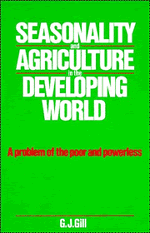Book contents
- Frontmatter
- Contents
- List of illustrations
- List of tables
- Preface
- Acknowledgements
- 1 Introduction
- 2 The sources of seasonality
- 3 Seasonality and the disadvantaged
- 4 Seasonality and the environment
- 5 Coping with seasonality
- 6 Seasonal labour migration
- 7 Special problems of developing countries: I: Market failure and market distortions
- 8 Special problems of developing countries: II. Technological change in a changing environment
- 9 Implications for policy and planning
- Appendix: Seasonal labour migration at the national level: An approach to rapid appraisal
- Notes
- References and sources
- Index
8 - Special problems of developing countries: II. Technological change in a changing environment
Published online by Cambridge University Press: 20 May 2010
- Frontmatter
- Contents
- List of illustrations
- List of tables
- Preface
- Acknowledgements
- 1 Introduction
- 2 The sources of seasonality
- 3 Seasonality and the disadvantaged
- 4 Seasonality and the environment
- 5 Coping with seasonality
- 6 Seasonal labour migration
- 7 Special problems of developing countries: I: Market failure and market distortions
- 8 Special problems of developing countries: II. Technological change in a changing environment
- 9 Implications for policy and planning
- Appendix: Seasonal labour migration at the national level: An approach to rapid appraisal
- Notes
- References and sources
- Index
Summary
In many rural parts of the Third World, the counter-seasonal technologies, techniques and strategies which people have developed over the millennia, are coming increasingly under threat. The sources of this threat are many and varied, but they can usefully be grouped under two broad and interacting categories: resource depletion and technological change. At one time it would have seemed strange to describe the latter as a threat, when it was widely perceived as a solution – often as the solution – to the problems of poor countries. Indeed it would still be very difficult to envisage any sustained degree of economic development without such change. However, the problems of inappropriate technology in developing countries are now recognized as being very real. The arguments are also exceptionally well documented, and there is no need to repeat them here. Like poverty itself, however, the whole issue of technological choice in poor countries has a seasonal aspect that is not at all fully understood or appreciated. Before going on to consider this aspect, however, it is worth examining briefly the seasonality implications of the background of steady depletion of agricultural and other resources against which technological change must take place, for this is a context that makes the devising of appropriate counter-seasonal technologies at once more difficult and more pressingly urgent.
Resource depletion
The term ‘resource depletion’ is used here in a broad sense to cover a number of related problems.
- Type
- Chapter
- Information
- Seasonality and Agriculture in the Developing WorldA Problem of the Poor and the Powerless, pp. 173 - 213Publisher: Cambridge University PressPrint publication year: 1991



